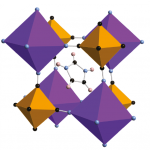We have a longstanding interest in the family of Prussian blue analogues: metal ions bridged by cyanide linkers into a cubic framework that can accommodate many different guests in the pores. In a paper just published in CrystEngComm, arising from Helen Duncan’s PhD work, we use total neutron scattering measurements at ISIS to investigate one of these materials that contains planar imidazolium ions in the interstices.1 (more…)
Distortion modes in conventional and hybrid double perovskites

Many functional materials have the perovskite topology. The functionality, however, invariably comes from some distortion away from the ideal cubic perovskite structure. For instance, electrical polarisation arises from distortions that remove the centre of symmetry. The hybrid perovskite analogues, which consist of metal coordination octahedra connected by polyatomic linkers, are widely recognised to be more mechanically flexible than the inorganic perovskites, in which these octahedra actually share vertex atoms. With a view to understanding the actual and potential functionality of the hybrid perovskites, there has thus been substantial interest in the distortion modes that characterise their observed phase transitions.
